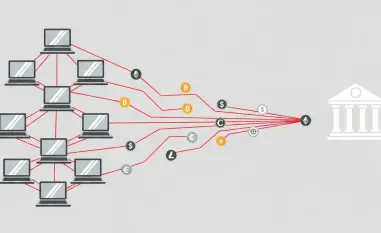Ransomware attacks have become a significant threat to organizations across the globe, exploiting vulnerabilities in their cyber defenses and inadequate security measures, thereby underscoring the critical need for proactive Attack Surface Risk Management (ASRM). These attacks involve malicious actors encrypting an organization’s data and demanding a ransom for its release. They can severely cripple operations, lead to substantial financial losses, and inflict lasting reputational damage. As ransomware tactics continue to evolve, organizations must fortify their cybersecurity measures to stay ahead of these persistent threats.
In far too many cases, organizations fall prey to ransomware due to relatively simple and avoidable vulnerabilities within their systems, such as outdated software, weak security configurations, and inadequate monitoring. Attackers take advantage of these weaknesses, gaining unauthorized access to deploy ransomware. The financial and operational impact of such attacks can be devastating, emphasizing the need for robust and proactive risk management strategies. By addressing these vulnerabilities head-on, organizations can significantly reduce their risk of falling victim to ransomware.
Understanding the Ransomware Threat
Ransomware attacks have drastically evolved over the years, becoming more sophisticated and harder to detect, making them one of the most severe threats to cybersecurity today. In essence, ransomware is a type of cyber extortion where attackers use malicious software to lock or encrypt an organization’s data, demanding a ransom to restore access. The consequences of a successful attack can be catastrophic, halting business operations, leading to substantial financial losses, and eroding customer trust and organization reputation.
A key factor in the rising success of ransomware attacks is the exploitation of vulnerabilities in organizational systems. Attackers commonly exploit weaknesses such as outdated software, misconfigured security settings, and the absence of continuous monitoring. Once inside, they deploy their ransomware, often leveraging stolen credentials or exploiting unpatched software vulnerabilities. This emphasizes the critical need for organizations to regularly update their software, strengthen their security configurations, and maintain a comprehensive monitoring system to detect potential threats promptly.
The Role of the Cyber Risk Index (CRI)
The Cyber Risk Index (CRI) plays a pivotal role in the fight against ransomware and other cyber threats by serving as a metric that quantifies an organization’s overall security risk. This index aggregates individual asset and risk factor scores to provide a comprehensive view of the organization’s security posture. The CRI is invaluable in identifying vulnerabilities, prioritizing risk mitigation efforts, and guiding decision-making processes to enhance cybersecurity measures effectively.
A high CRI is a red flag, indicating a greater susceptibility to cyber threats, including ransomware. By continuously monitoring and managing their CRI, organizations can proactively address vulnerabilities before they are exploited by malicious actors. The CRI serves as a vital tool in assessing security health, allowing organizations to implement necessary improvements to lower their risk profile. With a lower CRI, organizations can mitigate potential threats and strengthen their defenses against ransomware attacks.
Attack Surface Risk Management (ASRM)
Attack Surface Risk Management (ASRM) is a comprehensive approach that goes beyond traditional Attack Surface Management (ASM). It involves a structured process of identifying, prioritizing, and mitigating risks across an organization’s attack surface. ASRM provides thorough risk assessments, prioritizes actions, and implements countermeasures to address identified vulnerabilities. This approach ensures that organizations maintain a robust security posture and reduce the likelihood of ransomware infections.
ASRM extends traditional ASM by offering continuous, automated monitoring of the attack surface to identify emerging vulnerabilities in real time. Organizations can then take proactive measures to address these vulnerabilities before they can be exploited by cybercriminals. By leveraging ASRM, organizations can visualize and manage their attack surfaces more effectively, foresee potential threats, and execute timely interventions to mitigate them. This proactive stance is essential in maintaining security resilience against sophisticated ransomware attacks.
Correlation Between Risk Index and Ransomware
Studies and real-world data have shown a clear correlation between higher Risk Indices and increased susceptibility to ransomware attacks. Organizations with high Cyber Risk Index (CRI) values are statistically more likely to experience ransomware infections compared to those with lower CRI values. This correlation underlines the critical importance of maintaining a low Risk Index as a defensive measure against cyber threats.
For instance, an analysis of data collected from 6,588 organizations during the first half of 2024 revealed stark differences in Risk Index scores between those attacked by ransomware and those that remained unaffected. Organizations targeted by ransomware had an average Risk Index of 52.38, significantly higher than the 40.25 average of their uninfected counterparts. These findings underscore the pressing need for proactive and continuous risk management strategies to effectively reduce the Risk Index and mitigate the risks of ransomware.
Component Indices: Attack, Exposure, and Security Configuration
The comprehensive assessment provided by the Cyber Risk Index (CRI) is divided into three critical sub-indices: the Attack Index, the Exposure Index, and the Security Configuration Index. Each sub-index offers unique insights into different aspects of an organization’s risk profile, which is crucial for identifying specific areas that require attention and targeted interventions.
The Attack Index measures the likelihood of an organization being targeted by cyber threats, reflecting the attractiveness or vulnerability of the organization to potential attackers. The Exposure Index assesses the organization’s exposure to potential vulnerabilities, encompassing aspects like system configurations and the presence of outdated software. The Security Configuration Index evaluates the effectiveness of the organization’s security settings and overall posture. Analyzing these component indices helps organizations develop targeted and effective strategies to address their unique risk factors and enhance their defenses holistically.
Importance of Proactive Measures
Proactivity is the cornerstone of effective cybersecurity. Implementing proactive measures is crucial for preventing ransomware attacks and maintaining a robust security posture. Organizations must continuously monitor their Risk Index and take immediate action to address vulnerabilities as they are identified. This includes applying necessary patches, disabling susceptible devices, and adjusting security configurations to mitigate risks.
In addition to technical measures, proactive cybersecurity also involves regular security assessments, comprehensive employee training programs, and thorough incident response planning. By staying ahead of potential threats and maintaining a vigilant, proactive approach, organizations can significantly reduce their risk of ransomware infections. This proactive stance not only helps in mitigating current threats but also prepares the organization to respond swiftly and effectively to emerging threats in the dynamic cyber landscape.
Comprehensive Risk Management Strategies
Effective risk management is not a one-time effort but requires a comprehensive, ongoing commitment. It involves both the visualization of risks and the implementation of actionable measures for mitigation. Organizations must leverage advanced tools and platforms, such as Trend Vision One, to gain a holistic view of their attack surfaces and execute targeted risk management strategies.
Comprehensive risk management encompasses continuous monitoring, regular security assessments, and proactive mitigation efforts. By adopting a holistic approach, organizations can ensure that all potential vulnerabilities are addressed. This reduces the likelihood of ransomware attacks and enhances their overall security resilience.
By integrating ASRM into their risk management framework, organizations can transition from a reactive to a proactive stance, identifying and addressing threats before they materialize. This approach not only helps in keeping the Risk Index low but also builds a culture of continuous improvement and vigilance within the organization, essential for navigating the ever-evolving threat landscape.
Statistical Analysis and Predictive Insights
One of the significant advantages of using metrics like the Cyber Risk Index (CRI) is the ability to derive predictive insights through detailed statistical analysis of accumulated data. By examining data from thousands of organizations, researchers can identify patterns and predict the likelihood of ransomware attacks based on CRI values. This predictive capability provides invaluable guidance in risk management and prioritization efforts.
For example, studies have shown that organizations with above-average Risk Indices are approximately 12 times more likely to suffer ransomware infections. This stark statistic serves as a wake-up call for organizations to prioritize reducing their CRI. By understanding the correlation between high CRI values and increased ransomware risk, organizations can focus their efforts on lowering their risk metrics, thereby significantly lowering the probability of falling victim to ransomware attacks.
Categorizing Risk Levels
To facilitate better risk understanding and management, organizations can categorize their Risk Index scores into specific risk levels such as low, medium, and high. By associating these categories with the likelihood of ransomware infections, organizations can develop targeted strategies to mitigate their unique vulnerabilities.
Implementing a categorization system based on Risk Index scores helps organizations focus their resources and efforts where they are most needed. For instance, entities with high-risk scores can prioritize critical interventions such as patch management and advanced threat detection, while those in the medium-risk category might focus on improving security configurations and employee training. This focused approach is essential for effective risk reduction and resource optimization.
In conclusion, lowering the Risk Index is vital for mitigating ransomware risks. The insights provided by detailed statistical analysis can empower organizations to compare their CRI against industry benchmarks and strive for values below the average, thereby ensuring a robust cybersecurity posture. By promoting effective cybersecurity strategies and continuous monitoring, organizations can transform from vulnerable to resilient, ensuring business continuity and reliability against the backdrop of ever-evolving cyber threats.













